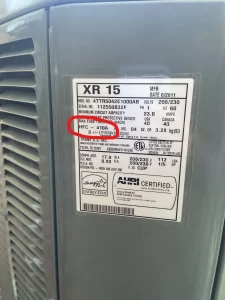
In 2025, homeowners will see a major change in the HVAC industry as two new refrigerants, R32 and R454B, become the primary options in new air conditioning systems. This shift is part of an industry-wide effort to phase out R410A, a common refrigerant in many current systems, in favor of more environmentally friendly alternatives. On January 1, 2025 R410A systems will stop being produced. If you’re a homeowner with an R410A system, here’s what you need to know about these changes and what to expect in the future.
Why the Change?
The short answer – the environment. The shift away from R410A is part of a larger initiative to reduce greenhouse gas emissions and the global warming potential (GWP) of refrigerants. Here’s a quick comparison:
- R410A: GWP of around 2,088
- R32: GWP of around 675 (approximately one-third the GWP of R410A)
- R454B: GWP of around 466 (even lower than R32)
These numbers represent how much each refrigerant can contribute to warming the atmosphere. The lower the GWP, the more eco-friendly the refrigerant.
What Does This Mean for Homeowners with R410A Systems?

If you currently have an R410A system, here’s some good news: you don’t need to replace it right away. R410A systems will still be supported, and you’ll be able to get refrigerant for repairs and maintenance for years to come. However, manufacturers are expected to stop producing new R410A systems as they phase in models compatible with R32 and R454B.
That said, there are a few important considerations for homeowners:
Service and Repairs
Technicians will continue to service R410A systems, but R410A refrigerant might become more expensive as production decreases. While it’s not necessary to rush into upgrading, you may want to keep this in mind when planning for future HVAC repairs or maintenance.
Replacement Costs
If your R410A system is nearing the end of its lifespan, consider budgeting for a new system with R32 or R454B refrigerant. This way, when it’s time to replace, you’ll be ready to make the upgrade. Newer systems often come with higher energy efficiency ratings, which can save you money on energy bills. Many R32 and R454B systems offer higher energy efficiency than older R410A systems, which can lead to significant savings on your utility bills over time. Look for high SEER (Seasonal Energy Efficiency Ratio) ratings as an indicator of better performance.
Safety
R32 and R454B have been widely tested and approved for safe residential use. R32 is slightly flammable, while R454B has a low flammability rating, but both are within safe limits for home HVAC systems. They pose no greater risk than common household products. Always work with a licensed professional to ensure proper installation, as safety standards will be a key factor in this transition.
Will I still be able to buy R410 units that have already been made?
Yes, but only for a limited time. There is a sell-through period of 1 year. This means that you’ll still be able to purchase R410A units in 2025 but after that no more will be sold.
I keep hearing A2L – what does that mean?
The terms A1 and A2L refer to classifications set by ASHRAE (American Society of Heating, Refrigerating, and Air-Conditioning Engineers) for refrigerant safety, specifically regarding flammability and toxicity.
A1 Refrigerants: The Standard in Non-Flammable Refrigerants
Flammability: A1 refrigerants are classified as non-flammable, making them the most stable choice from a fire-safety perspective. This has made A1 refrigerants a popular choice in residential and commercial applications where safety is a high priority.
Common A1 refrigerants include R410A (the current industry standard), as well as older refrigerants like R22.
Toxicity: Like all ASHRAE Class A refrigerants, A1 refrigerants are low in toxicity, meaning they have little or no risk of harming occupants under normal operating conditions.
A2L Refrigerants: Low GWP with Mild Flammability
Flammability: A2L refrigerants are classified as mildly flammable (the “2L” indicates the lowest level of flammability within the “A2” category). While this does introduce a slight increase in flammability risk, A2L refrigerants do not easily ignite and require specific conditions to do so (e.g., a specific concentration in air and a high ignition source).
Toxicity: Like A1 refrigerants, A2L refrigerants are also low in toxicity, meaning they are safe for use in homes when handled properly.
What Homeowners Should Know About A2L vs. A1 Refrigerants
Although A2L refrigerants are mildly flammable, they have been rigorously tested and deemed safe for residential use. Newer HVAC systems designed for A2L refrigerants include added safety measures, and professional installation is key to ensuring these systems are safe.
Quality Comfort is trained and licensed to handle these new A2L refrigerant types
When it comes time to replace your system, looking at these new alternatives will give you extended longevity of parts and refrigerant availability for your new investment. If you’re in the Cincinnati area and looking to replace your HVAC, don’t hesitate to reach out to us or book an estimate online!

